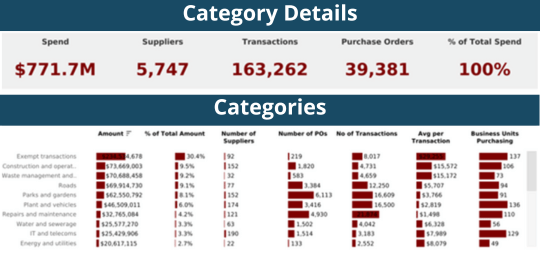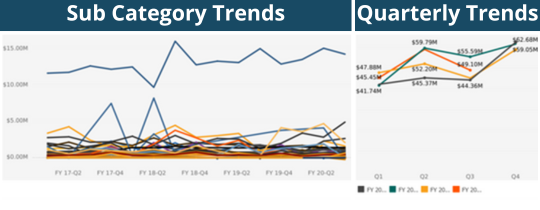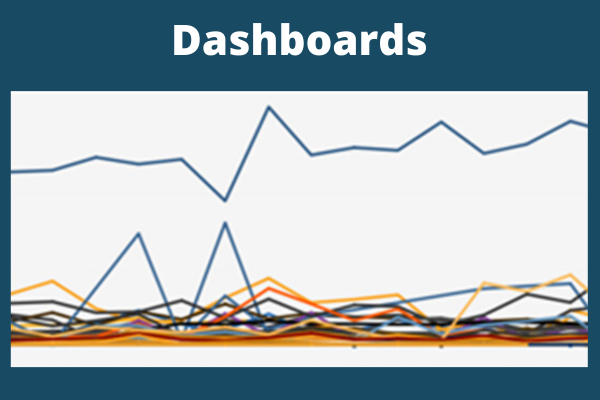Procurement Data Talks - Category Detail Report
By Glen Duff, Director Strategy & Partnerships
Looking for the article about our new Procurement Success Manager? Click here
In this series of procurement data discussions, we visit a new dashboard in detail. These dashboards are part of a full suite of 12 configurable reports provided to all Queensland councils under Local Buy’s fully funded procurement technology and data program.
We’ll share our thoughts about how council can use each dashboard to support both their operational and strategic priorities, to support council delivery and outcomes.
This month we continue from our Category Overview dashboard and look at the Category Detail dashboard (example below).
As the name suggests, Category Detail reports provide the next level of category details vital for councils to analyse and optimise spending patterns across different categories of goods and services. These reports provide valuable insights into how a council allocates its procurement budget, identifying areas of potential savings and opportunities for strategic sourcing initiatives. By understanding the distribution of spend across various categories, procurement professionals can make informed decisions about supplier selection and overall procurement strategies.
Local Buy’s procurement technology and data program will categorise council’s procurement spend profile into category and subcategory details aligned to the national procurement network categorisation taxonomy. This service is delivered using a raw data report from your council’s finance system, which is then processed by our service provider into professional procurement reports. We’re doing the difficult categorisation work so you don’t have to, and providing it in a way that’s easy to understand.
Key components of the Category Detail report include:
Categories:
Council spend is allocated against high-level categories i.e., Construction and Operations; IT and Telecoms, Roads or Plant and vehicles to name a few. By understanding the distribution of spend across high-level categories, procurement teams can prioritise their efforts and resources towards the most significant areas of expenditure. This report further details per category the % of Total Spend, Number of Suppliers/POs/Transactions, average value per transaction and business units spending against the category. These valuable fields can be further interrogated within the report.

Sub Categories:
Within each high-level category are sub categories which distributes spend further for more focused analysis. For example, under Construction and Operations is Building Construction; Engineering Consulting; Dredging etc. This level of detail enables council to focus on strategic sourcing initiatives and cost-saving opportunities in the most impactful sub categories. This report further details per sub category the % of Total Spend, Number of Suppliers/POs/Transactions, average value per transaction and business units spending against the sub category. These valuable fields can be further interrogated within the report.

Suppliers:
Easily identifies supplier spend amounts associated with each category and subcategory. By analysing supplier spend by category and subcategory, procurement teams can identify areas where they are overspending or where they could negotiate better prices. This granular level of insight enables them to target specific categories or sub categories for cost reduction initiatives, leading to overall savings.
Location:
By analysing supplier location, councils can identify opportunities to support local businesses and contribute to local economic development. This can enhance council reputation and strengthen its ties to the community. Councils can also identify which categories and sub categories of supply are provided by local suppliers, supporting informed strategies that can focus on supplier attraction and retention.
New Suppliers:
Identifying which categories and sub categories are attracting new suppliers can support council in understanding market depth at the category and sub category level as well as trends in supplier movements. This can support market analysis and also success of any supplier onboarding initiatives.

Sub Category Trends:
Understanding historical spending patterns and identifying trends enables council to make accurate budget forecasts and allocate resources effectively. They can anticipate future spending needs and make informed decisions about resource allocation. The quarterly breakdown delivers this data at a more granular level.

By leveraging these reports, provided under Local Buy’s procurement technology and data program, councils can optimise spending, improve supplier performance, and contribute to the overall financial health of the council.
Here are some additional tips I like to remember when using procurement reports effectively:
- Do not be afraid of data. It is easy to read these reports and quickly identify opportunities for council. Start off exploring want you want to learn.
- Use a variety of reports to get a complete picture of your procurement performance. Don't rely on just one type of report.
- Share your reports with the appropriate stakeholders. Make sure that the people who need to see the reports have access to them. Collective thinking can deliver great data results.
- Use your reports to take action. Don't just generate reports and then file them away. Use the information in the reports to make improvements to your procurement processes.
- These insights are just some of the data points available within the Category Detail dashboard. For Local Buy’s member councils, this dashboard serves as a powerful tool for procurement and other organisational stakeholders to gain an overview of procurement category detail data to make more informed category-based decisions.
If you would like to know more, please get in contact with Glen Duff, Director Strategy & Partnerships, Local Buy via gduff@localbuy.net.au.

